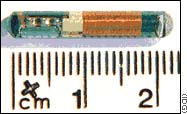
Prophecy
News - 666
"Surely
I am coming quickly."
Amen. Even so, come, Lord Jesus! Revelation 22:20
Is human chip implant wave of the future?
Is the human body a fit place for a microchip? The debate is no longer hypothetical. The same computing power that once required an entire building to harness now can be inserted in your left arm.
Professor Kevin Warwick, director of cybernetics at the University of Reading in the U.K., is that somebody else. On Monday, Aug. 24, 1998, Warwick became the first human to host a microchip. During a 20-minute medical procedure described as "a routine silicon-chip implant" by Dr. George Boulos, who led the operation, doctors inserted into Warwick's arm a glass capsule not much bigger than a pearl. The capsule holds several microprocessors.
The British Broadcasting Corp. was on hand to document the historic event - and to trouble the professor's already frayed nerves. "In theory, I was able to see what was going on," Warwick says in a phone interview several days after the operation (which he described as slightly more pleasant than a trip to the dentist), "but I was looking in the opposite direction most of the time."
Though he declines to reveal the chip's manufacturer, Warwick did disclose that it's a "commercial" product. "For obvious reasons, both positive and negative, they didn't want us shouting about what the name of the exact product was," he says.

The approximately 23mm-by-3mm device stayed in Warwick's arm for only nine days - partly to avoid medical complications, partly because it was fairly limited in power. "Half of it is an electric coil," Warwick says, "and half is a number of silicon chips." The chips used only eight of an available 64 bits of information to communicate with the University of Reading's intelligent building.
Real-world applications
Though the experiment sounds like an episode of Dr. Who, its real-world implications are "right around the corner," says Warwick, who foresees enormous medical applications. Through a system of embedded chips interfacing with an artificial motor system, Warwick imagines paraplegics walking. And that's just for starters.
"Simply take measurements off muscles and tendons and feed them into the transponder," Warwick says. "That means, ultimately, that you wouldn't need a computer mouse anymore. You wouldn't need a keyboard."
Charles Ostman, a senior fellow at the Institute for Global Futures and science editor at Mondo 2000, agrees. "Neuroprosthetics are . . . inevitable," he says. "Biochip implants may become part of a rote medical procedure. After that, interface with outside systems is a logical next step."
Full story from CNN - January 1999